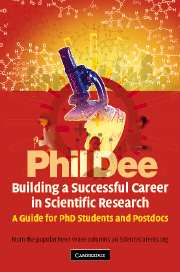Book contents
- Frontmatter
- Contents
- Foreword
- Preface
- PART I The first couple of years
- PART II The end of the beginning
- PART III The transition to post-doctoral research
- 10 From graduate student to post-doc
- 11 Collaboration and visiting other labs
- 12 Supervising students in the lab
- 13 Teaching
- 14 Writing grant proposals and fellowship applications
- PART IV Making it in science
- Epilogue
- Web-links
- Index
- Frontmatter
- Contents
- Foreword
- Preface
- PART I The first couple of years
- PART II The end of the beginning
- PART III The transition to post-doctoral research
- 10 From graduate student to post-doc
- 11 Collaboration and visiting other labs
- 12 Supervising students in the lab
- 13 Teaching
- 14 Writing grant proposals and fellowship applications
- PART IV Making it in science
- Epilogue
- Web-links
- Index
Summary
Freed from the steep learning curve of a Ph.D. and not yet burdened by a snowdrift of administrative paperwork, post-docs are the full-time researchers, are they not? Yet, if you are ever to aspire to have your own independent research group, you must get hold of the teaching skills you will need when faced with the demands of your first lecturership. Teaching is also one excellent way to learn how to improve your ability to communicate science. We all know the pre-eminence of excellent communication skills amongst the most successful members of our research communities. OK, so a class of first-year undergraduates may seem a world apart from our peers at a scientific conference, and we might need to dumb down quite a lot to reach them with our message. But, in all instances, we should adapt our content and delivery to suit our audience. And, if you are able to tailor your message to make it interesting and accessible to undergrads, then doing the same thing for your peers should be a piece of cake. It really is just a question of selectivity.
One of my first challenges on this long walk to lecturer status was self-imposed. I volunteered not only to run an undergraduate practical class, but also to design it from scratch. I found that the time-honoured practical class can be a microcosm of teaching practice.
- Type
- Chapter
- Information
- Building a Successful Career in Scientific ResearchA Guide for PhD Students and Postdocs, pp. 91 - 96Publisher: Cambridge University PressPrint publication year: 2006



